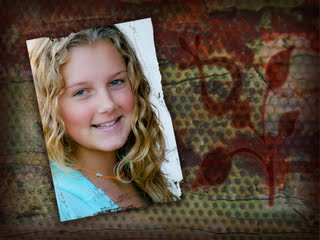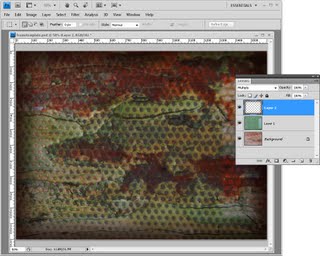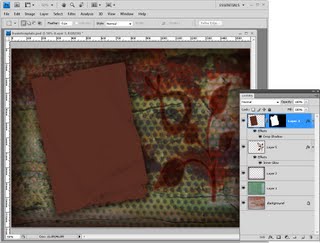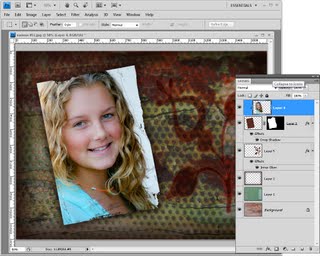Learn to make a silhouette in Photoshop and, from that, create an outline of the shape and a pattern fill for the shape. Tools used include the Quick Select tool, Refine Edge, Selection Smooth tool, Pattern Fill Layer, Stroke Layer Style and more.
Transcript:
Hello, I’m Helen Bradley.
Welcome to this video tutorial. In this tutorial I’m going to show you three options that you can use to create silhouettes in Photoshop and I’m using some old vintage clipart to show you how to do this. As usual before we get started let’s have a look and see what it is that we’re aiming to achieve.
I have this image of a red deer head which is an old scanned free image that I found from a public domain site and I wanted to look at some ways that I could use this image in my art but perhaps giving it a little bit of a different flavor. And this is one of the ways that I’m going to show you what we’re doing is making a selection or a silhouette of the deer head and filling it with a pattern or showing it filled as a pattern. This is another one of the options that I’m going to show you how you can create it as an edge effect. And finally we’ll look at creating it as a silhouette itself. So if you’re ready let’s get started working with our image. I have my deer head image here and this is the original scanned image that I downloaded from a public domain website.
The first thing we need to do is to make a selection of the deer head. It’s probably going to be easier to select the white area so I’m going to try with the Quick Select tool and just select over the white areas of the image leaving the deer itself intact and not selected. If I go too far I can hold the Alt key and drag out or I can add to the selection here. I might need to zoom in a little bit to make sure that I haven’t gone too far. This is looking pretty good to me. So I’m going to zoom a bit and let’s just test it by choosing Select and then Refine Edge and that will tell me if I’ve got it right. Well, I’ve got a few areas to tidy up. I’m just going to go back and select those and let’s continue once I’ve made those selections.
Now I’ve done a little bit more work on this image and I’m reasonably pleased with the result that I’ve got. This is what I’ve got so far. I would clean up a few of these areas if I were being a little bit more careful, had a bit more time. But basically that’s a pretty good selection for now. Now that I’ve got that selection I’m going to create a mask from it by just clicking the Layer Mask icon here. And because my mask has gone the wrong way I’m just going to click it and press Ctrl and I to turn it around the other way. We can test the mask by adding a color filled layer beneath the image. Now at the moment this image is a grayscale image so I’m going to convert it first into RGB color mode.
I’m not going to merge it so I’m just going to click Don’t merge. And now that it’s a color image I can add a color background behind this deer head which I’m going to do just so that we can check and see how it’s looking. At this point you could continue working on the image by painting on the mask using black and white so that you get a really, really good selection. But let’s assume that we’ve done that. For our first silhouette effect we’re just going to Ctrl and click on the mask because that will give us a selection of the deer head. I’m going to create a brand new layer and let’s just turn off the existing layer and let’s see what it looks like when it’s filled with black. I’ve pressed D to set the default foreground and background colors.
I’m going to press Alt Backspace to fill it with black and then Alt D to deselect the selection. Now ignoring the slight problem areas we’ve still got a fairly pixelated edge. So I’m going to trash that and go back and grab my mask selection, add a new layer and before I fill it this time let’s smooth it. I’ll choose Select and then Modify and then Smooth and I’ll smooth it by a couple of pixels. And now I’ll fill it. And you can see that this time we’ve got a much smoother edge. And we could smoother by even more pixels and we would get a much better result each time. So there’s one of the options that you have of creating a silhouette from an image. But let’s go one step further. Let’s turn this off and let’s go and get our selection again. I’m going to add a brand new layer.
This time let’s smooth it by three pixels and see if we get a slightly better result still. And I’m going to fill it with a color and it doesn’t matter what color I fill it with but let’s do black for argument sake. And I’m going to deselect my selection. This time I just want the white outline. So, on this fill layer I’m going to take the fill to zero so I’m effectively filling the layer with the deer shape but then turning that off. Now that might sound counterintuitive but look what happens when we select a layer style and add a stroke. I’m going to click on the stroke. You can see immediately we’re getting this stroked outline for this deer head. Now if I want it to be white I can just come in here and I’m just going to type the numbers for white which are 255, 255, 255 and click Ok. I can choose outside or center.
I could even do inside but I think that center is probably going to give me the best results here. And I can size my outline to whatever I want it to be and just click Ok. So that’s a filled layer with the fill turned off but with a white stroke to give us this outline shape. So, so far we’ve got two versions of our silhouette. One’s a black and white and one is an outline. And let’s create another one, a third one. I’m going to take this silhouette and I’m going to duplicate it. So let’s just move that up to the top here and turn the other layers off. Now what I want to do is to fill this area here with a pattern. So I’m going to choose Layer, New Fill Layer, Pattern and I’m going to choose this pattern this square pattern.
But its way, way too big so I’m going to scale it down to about 10 percent, maybe even 5 percent so it’s a nice small pattern. And I’ll click Ok. Now what I want to do is I want to make this pattern fill layer just the shape of the layer underneath and I can do that by creating a clipping mask. So I’ll select this pattern layer and choose Layer, Create Clipping Mask. And so I’ve clipped the pattern to the shape of the deer head. So there are a few options that you have for working with something like a clipart image, this clipart image of a deer head which I then extracted so I was able to do something with it. And what we did with it was to fill the selection with black to create a silhouette.
We can also fill it with black, or any color indeed, make the fill invisible and then stroke it to get a stroked outline. And the final feature allows us to fill the silhouette with a pattern. And if we wanted to we could even go and borrow the white outline from the layer below.
I’m Helen Bradley.
Thank you for joining me for this video tutorial. Look out for more of my tutorials on this YouTube channel. And visit my website at projectwoman.com for more tips, tricks and tutorials on Photoshop, Photoshop Elements, Illustrator, Lightroom and a whole lot more.





